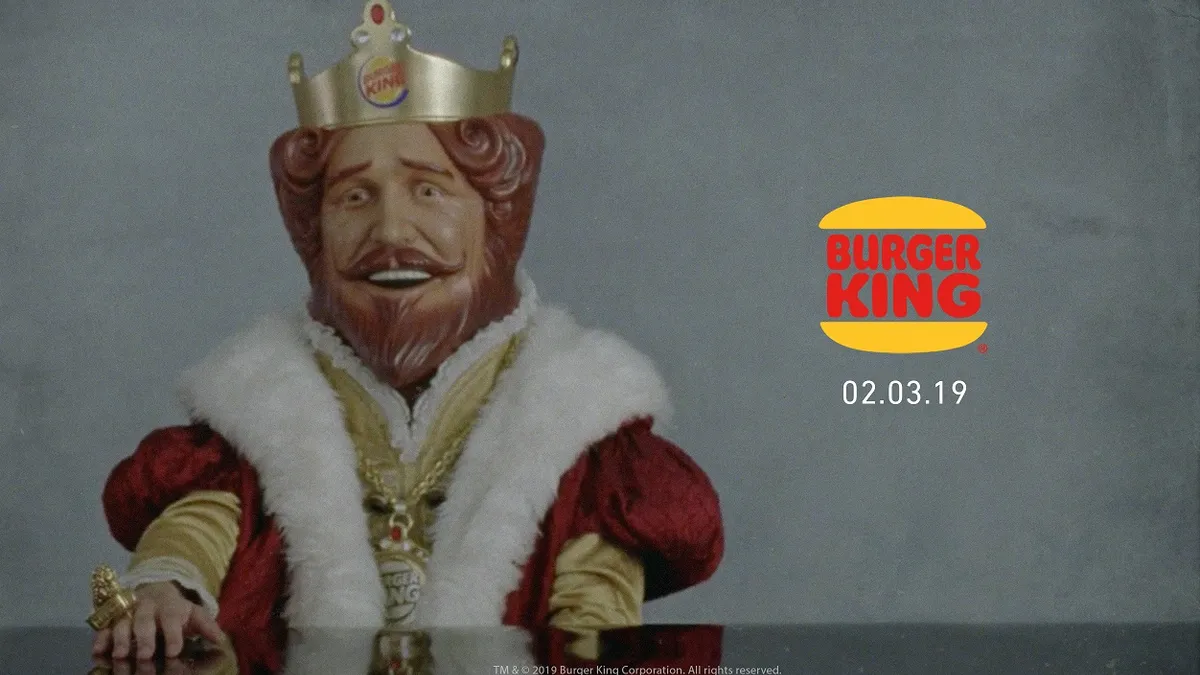Burger King’s mysterious Super Bowl teaser likely raised many eyebrows, but its game day ad featuring Andy Warhol eating a Whopper likely confused those who didn't participate in its promotion. Last week, customers who ordered Burger King through DoorDash using a special code received a free "mystery box" from the burger chain that contained a wig, an old Burger King wrapper, empty ketchup bottle and coupon for a free Whopper and delivery via DoorDash. The point of the bundle was to let customers "eat like Andy" while watching the ad, but will this move boost foot traffic for the chain?
"Super Bowl ads are more of a brand awareness play," Cuebiq founder and CEO Antonio Tomarchio told Restaurant Dive.
Cuebiq, which analyzed footfall data 21 days before and 21 days after Super Bowl LII found that Wendy’s foot traffic jumped 3.3% after running an ad last year, while Jack in the Box's traffic increased only 0.5% after running its ad.
Not many QSR brands took part in a Super Bowl ad campaign this year. While Pizza Hut sponsored the NFL and McDonald's ran a bacon-oriented ad right during the pre-game, neither actually ran ads during the big game. Restaurant chains may not see as much value in the investment, Tomarchio said.
"Footfall traffic can be generated by Super Bowl ads, but not enough for immediate footfall gains," he said.
A Super Bowl ad can be incredibly expensive. This year, ads cost a reported $5.25 million for 30 seconds of air time, which doesn’t include the millions brands spend on pre-releases and teasers.
Many brands have instead doubled-down on game day promotions to get people in the door before, during and after the big game. Chains also have been using the promotions to highlight their delivery partnerships. With 14 million people expected to call out sick on the Monday after the Super Bowl, BJ's Restaurant partnered with DoorDash to offer free delivery and a free Chocolate Chunk Pizooki to people skipping work. Jack in the Box also is offering a Super Jack'd Monday box via DoorDash with tacos, curly fries, chicken nuggets and egg rolls on Monday only.
"Footfall traffic can be generated by Superbowl ads, but not enough for immediate footfall gains."

Antonio Tomarchio
Founder and CEO, Cuebiq
Promotions in general are more impactful to consumers because they create more of an immediate value for consumers, Tomarchio said, whereas a brand awareness campaign might have more long-term effects to get consumers in the door at a later date.
But measuring the success of these campaigns in the long-term can be difficult.
QSR brands should be using all the potential tools at their disposal to better understand the long-term impact of marketing initiatives, such as Super Bowl ads, Tomarchio said. One way of doing so is using location data.
These tools can help stores understand how well marketing campaigns drive footfall traffic and brand loyalty, how they are doing compared to competitors and other pertinent information, he said.
He said QSRs could really benefit from the various opportunities that location data can provide, especially given common consumer behavior at fast food restaurants. It can help monitor where customers go before they visit a QSR chain, such as the movies, and how many times they might visit another competitor each month.
Burger King has already been using location data. During a marketing campaign last year, it used geofencing and gave customers one-cent Whoppers if they ordered from its BK App within 600 feet of a McDonald’s.
Tomarchio said QSRs are ideally positioned to be pioneers in location data insights.
"It's an environment where first-party data is not very rich so having these tools is very imperative," he said.










